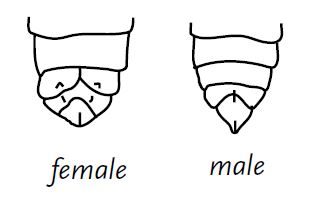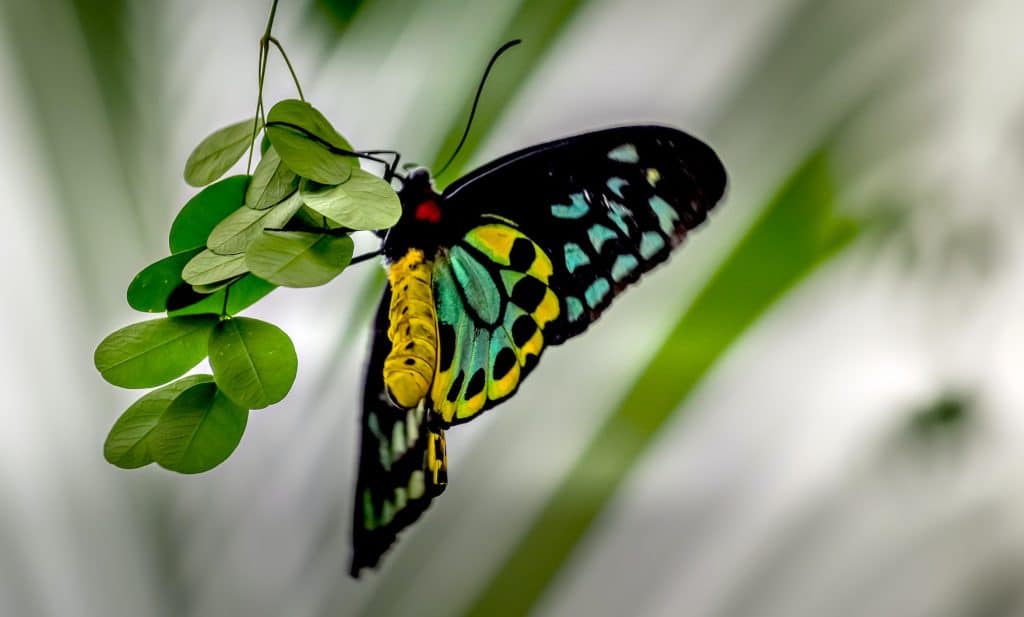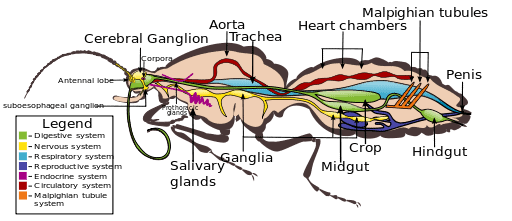Butterflies are wonderful creatures in the order of Lepidoptera which are insects with scaled wings. They can be of different sizes, colors, and shapes all around the world except Antarctica. These wonders of nature are known for their colorful beautiful wings and their ability to fly long distances despite their light-weighted body and delicate wings. But that’s not all, these incredible butterfly facts will literally blow your mind.
Here are some bizarre facts about these amazing insects (#17 is the weirdest among them):

1. Butterfly wings are transparent
You might think this is crazy, but the colors and patterns of butterfly wings are just one of the layers of their wings. Their wings are made up of several thin layers of protein namely “Chitin”. They are covered with a sophisticated microscopic scale system that gives the butterflies unique patterns and colors.
2. Butterfly Species: About 17,500
In General, about 17,500 species of butterflies have been found, to date, all over the world. While the majority has distinctive patterns, some species appear to be incredibly similar. The rarest among these species is the “Palos Verdes Blue” with an estimated headcount of only 300 butterflies.
Unfortunately, these numbers are in decline as they are threatened with extinction. Urbanization is the main reason the cause this decrease in their numbers
3. Butterflies use their feet to taste
Strange as it may sound, butterflies cannot taste their nutrition. Unlike other animals, they don’t use taste buds to taste food. Instead, butterflies have chemical receptors, called “chemoreceptors”, all over their bodies and their antenna with a high concentration in their feet. These receptors allow them to locate nectar and mates.
When a butterfly lands on a plant or a flower, it uses these receptors to detect whether they are a good source of nutrition or not. Female butterflies also use them to locate a suitable plant to lay their eggs.
4. The most common butterfly in the US is the Monarch butterfly
It has been estimated that there are almost 750 species of butterflies in the US, which represents about 4.2% of all species globally. The most common butterfly in the US is the “Monarch” along with other species such as the “Eastern tiger swallowtail”, “Cabbage White”, “Tiger Swallowtail” and “Black Swallowtail”.
5. Butterfly Gender
Butterflies are dimorphic species, which means the appearance of the males and females are different. While this might not be visible to the naked eye, there are some attributes that differentiate males from females. Thus, male butterflies might have brighter colors, which is used to attract females. Other characteristics also can be identified such as size, patterns, and reproduction organs. Visible claspers at the bottom of the male body are an obvious difference in many species (As shown in the below diagram)

6. The largest butterfly is the “Queen Alexandra’s birdwing”
According to Wikipedia and other resources, the “Queen Alexandra’s birdwing” (Ornithoptera Alexandrea) is considered to be the largest butterfly with a wingspan of approximately 25cm to 28cm (9.8 inches to 11 inches). This giant Queen can be only found in the Oro Province in eastern Papua New Guinea.
The trade of this species, among others, is illegal due to the fact that they have been listed as endangered.

7. Butterflies have a liquid diet
Unlike caterpillars, adult butterflies don’t have teeth. Therefore, they have to extract their nutrition from flowers using a sucking mechanism. They feed through an organ called “proboscis”, a straw-like tube-shaped sucking organ. The proboscis, which is curled up when not in use, enables a butterfly to sip the nectar from the flowers to feed on by using it as a “Straw” that is inserted deeply into the flowers’ tubes. Thus, their diet is completely liquid.
If you are curious about butterflies’ diet, I have written a blog post about What do Butterflies eat?
8. Butterfly wings help them against predators
Each living organism is on the food chain of other predators. Butterflies, like others, have defense mechanisms to keep predators away. They basically use 2 types of mechanisms using their wings:
- Crypsis: Butterflies camouflage by folding their wings up to hide their bright colors and blend in with the surroundings. That way they reveal the bottom side of their wings.

- Mimicry: Another skill that has been honed by butterflies is mimicking their surroundings using their wing patterns and colors. This technique is known as “Mimicry”, in which the butterfly is pretending to be a poisonous flower using their bright colorful wings to keep them safe from predators.

9. Butterflies actually have four wings, not two
Did you know that butterflies actually have four wings, not just two? That’s true, you always see them fluttering around with those big, colorful wings, but it turns out they’ve got a whole other set of wings hidden under the ones you can see. Those hidden wings are actually called “hind wings” The set of “forewings” generates more power for them to fly, while the “hind wings” generate less power, mostly for lift generation. These 2 sets of wings work like propellers in eight patterns, unlike birds flapping their wings up and down, pushing the butterfly through the air.
10. Butterflies can see a wide spectrum of colors, including ultraviolet colors
While butterflies are nearsighted, they can actually see a wide spectrum of colors, including ultraviolet colors that we, humans, can’t see. Thanks to their compound eyes composed of thousands of “ommatidia” (pigmented photoreceptor cells). These compound eyes make them capable of seeing different shades and hues.
Butterflies use their color distinguishing mechanism to locate food, mates, and nectars in flowers. The nectar of a flower will change color when not in production. Their sight ability also helps them to stay away from predators.
11. The Fastest butterfly flight speed is 37 miles per hour
That’s pretty fast for an insect that weighs only as 2 petals of a flower. However, the truth is that “Skippers”, which are natural sprinters, have recorded a world-new record of 37 miles per hour. This is almost the speed of a car on an average driving route.
Having that said, the average butterfly flies about 5 to 12 Miles per hour. It has been found, on the other hand, that skippers when startled, they react twice as fast as a human does. This impeccable speed protects them from possible threats and to dodge potential predators.
12. Butterflies cannot fly if their body temperature is less than 75 to 112o F degrees
Temperature plays a vital role in the life of butterflies. In General, to be able to fly, the muscles of the thorax that generate power in the wings must be in the range of about 75 to 112o F. This means that air temperature should be at least 55o F. The difference between air temperature and body temperature is due to the stored heat that butterflies gain during their “Basking”, a behavior that butterflies do to absorb heat from the sun, similar to sunbathing. Another form of heat is internally generated caused by the high vibrating rate of their wings during their flight. At low temperatures, the butterfly awaits another opportunity to bask.
13. Antarctica is the only continent on which no Lepidoptera have been found.
Despite the fact of the existence of about 17,500 species, not even a single one can be found in “Antarctica”. As discussed earlier the importance of temperature to butterflies and how they impact their ability to fly, it seems that the temperature in “Antarctica” wasn’t in their favor. The average annual temperature in Antarctica varies between 14o F to -76o F, making it an unsuitable habitat for butterflies.
14. Butterflies have their skeletons on the outside of their bodies
Butterflies are invertebrates. This means that they lack a vertebral column, in other words, a backbone. Butterflies are exoskeletons, which means that they have an external skeleton that protects their bodies. This exoskeleton shell is made up of a protein called “Chitin”, a chain of glucose molecules that provide toughness and rigidity when they interlink.
15. A Newly Emerged Butterfly Can’t Fly
Once butterflies emerge, their wings will look wrinkled or folded. At this point, the butterfly won’t be able to fly. That’s because their wings are moist, soft, and vulnerable. A drying process then starts by pumping a substance called “meconium” into the veins of their wings to expand them. This substance would then revert to their bodies leaving only a small amount in the veins of the wings.
In about 30 minutes to 2 hours, depending on the size of the butterfly, this small amount will dry out, providing the wings with a more sturdy structure that will allow the butterfly to take off for the first time.
16. Butterflies have a heart (or Two)
Many might think that these cold-blooded insects don’t have a heart. Another misconception is that they have two hearts as spread by others. Well, the truth is, they do have a heart but not in the form that we know. Butterflies have three parts in their Thorax that contains their heart, digestive, and reproductive organs. Their circulatory system is composed of a long vessel that pumps blood (the heart) which contains 2 or 3 chambers. This is where the misleading information arouse of butterflies having 2 hearts.
If you look closely in the diagram below (Photo credit: Bugboy52.40, CC BY-SA 3.0, via Wikimedia Commons) you will notice the heart chambers in the middle of the Thorax.

17. Butterflies Hear With their Wings
I’m sure this one is really hard to believe. However, in 2009 scientists from the University of Bristol discovered that butterflies have a great hearing system under their wings. The structure of this system sits at the base of their wings and is a rubber-like stretched sheet. This membrane is attached to sensory organs responsible for converting sound into signals.
The membrane has been tested, using a tiny laser beam, while in action, and found that vibration occurs in the outer membrane with a low pitch, while the entire membrane vibrated with a higher pitch.
18. Butterflies don’t feel pain
A lot may ask, Do butterflies feel pain?
Based on scientists’ opinions, butterflies do not have pain receptors. Thus, they do not feel pain. However, they can feel and react when touched. They might also feel discomfort.
Vertebrates have a nerve system connected to the spine, which is responsible to convey the signal to the brain, which in return results in the reaction to avoid threat or danger, such as touching a hot pot. Since butterflies are invertebrates, they lack the backbone (or the skeleton) and the nervous system with pain receptors. Instead, they have what is called “subesophageal ganglion”. A ganglion is a dense mass of nerve cells that are used to control muscles or process input from the insect’s senses.
19. Butterflies live for 2 – 4 weeks on average
The lifespan of a butterfly varies greatly depending on the species. Some species of butterflies may live for only a few days, while others can live for several months. For example, the painted lady butterfly (Vanessa cardui) has a lifespan of about 15 – 29 days as an adult. Factors that can influence a butterfly’s lifespan include the availability of food and shelter, the presence of predators, and environmental conditions such as temperature and humidity.
20. Butterflies Migrate about 3,000 Miles
Temperature plays a vital role in the life of butterflies. Because butterflies cannot withstand the coldness of some areas, they do migrate to other warmer areas. A great example of butterfly migration is the monarch butterfly (Danaus plexippus). Their migration takes place on annual basis from the United States and Canada to central Mexico. The longest migration is known by the monarch butterfly which can reach up to 3,000 miles.
Recent Posts
How Can I Create A Habitat For Skipper Butterflies In My Garden With 3 Easy Plants
Skipper butterflies are a diverse group of insects that are found all over the world. They are known for their quick, darting flight and their often colorful wings. Skippers are attracted to...
Common Species Of Butterflies In Maryland: 21 Unique Species
Maryland is home to a variety of beautiful butterflies, from the large and showy Eastern Tiger Swallowtail to the tiny and delicate Blue Dasher. There are over 150 species of butterflies in Maryland,...
